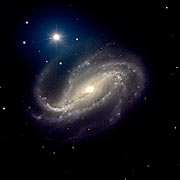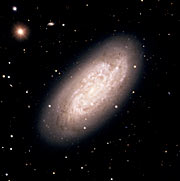Lehdistötiedote
Three Dusty Beauties
New Portraits of Spiral Galaxies NGC 613, NGC 1792 and NGC 3627
19. joulukuuta 2003
Not so long ago, the real nature of the "spiral nebulae", spiral-shaped objects observed in the sky through telescopes, was still unknown. This long-standing issue was finally settled in 1924 when the famous American astronomer Edwin Hubble provided conclusive evidence that they are located outside our own galaxy and are in fact "island universes" of their own. Nowadays, we know that the Milky Way is just one of billions of galaxies in the Universe. They come in vastly different shapes - spiral, elliptical, irregular - and many of them are simply beautiful, especially the spiral ones. Astronomers Mark Neeser from the Universitäts-Sternwarte München (Germany) and Peter Barthel from the Kapteyn Institute in Groningen (The Netherlands) were clearly not insensitive to this when they obtained images of three beautiful spiral galaxies with ESO's Very Large Telescope (VLT). They did this in twilight during the early morning when they had to stop their normal observing programme, searching for very distant and faint quasars.
The resulting colour images were produced by combining several CCD images in three different wavebands from the FORS multi-mode instruments.
The three galaxies are known as NGC 613, NGC 1792 and NGC 3627 . They are characterized by strong far-infrared, as well as radio emission, indicative of substantial ongoing star-formation activity. Indeed, these images all display prominent dust as well as features related to young stars, clear signs of intensive star-formation.
NGC 613
NGC 613 is a beautiful barred spiral galaxy in the southern constellation Sculptor. This galaxy is inclined by 32 degrees and, contrary to most barred spirals, has many arms that give it a tentacular appearance.
Prominent dust lanes are visible along the large-scale bar. Extensive star-formation occurs in this area, at the ends of the bar, and also in the nuclear regions of the galaxy. The gas at the centre, as well as the radio properties are indicative of the presence of a massive black hole in the centre of NGC 613.
NGC 1792
NGC 1792 is located in the southern constellation Columba (The Dove) - almost on the border with the constellation Caelum (The Graving Tool) - and is a so-called starburst spiral galaxy. Its optical appearance is quite chaotic, due to the patchy distribution of dust throughout the disc of this galaxy. It is very rich in neutral hydrogen gas - fuel for the formation of new stars - and is indeed rapidly forming such stars. The galaxy is characterized by unusually luminous far-infrared radiation; this is due to dust heated by young stars.
M 66 (NGC 3627)
The third galaxy is NGC 3627, also known as Messier 66, i.e. it is the 66th object in the famous catalogue of nebulae by French astronomer Charles Messier (1730 - 1817). It is located in the constellation Leo (The Lion).
NGC 3627 is a beautiful spiral with a well-developed central bulge. It also displays large-scale dust lanes. Many regions of warm hydrogen gas are seen throughout the disc of this galaxy. The latter regions are being ionised by radiation from clusters of newborn stars. Very active star-formation is most likely also occurring in the nuclear regions of NGC 3627.
The galaxy forms, together with its neighbours M 65 and NGC 3628, the so-called "Leo Triplet" ; they are located at a distance of about 35 million light-years. M 66 is the largest of the three. Its spiral arms appear distorted and displaced above the main plane of the galaxy. The asymmetric appearance is most likely due to gravitational interaction with its neighbours.
Lisätietoa
Technical Information : The images were taken by Mark Neeser (Universitäts-Sternwarte München, Germany) and Peter Barthel (Kapteyn Astronomical Institute, Netherlands) during twilight on the nights of 16-18 December 2001 with the FORS multi-mode instruments attached to the VLT-MELIPAL (FORS1) or VLT-YEPUN (FORS2). Each galaxy was observed in three different wavebands for up to 300 seconds per waveband, and the image obtained in each waveband was associated to a colour: B (blue), V (green) and R (red). Neeser and Barthel also performed the first stage of the image processing; further processing and colour-encoding was made by Hans-Herman Heyer and Henri Boffin (ESO).
Yhteystiedot
Richard West
ESO
Garching, Germany
Puh.: +49 89 3200 6276
Sähköposti: rwest@eso.org
Tiedotteesta
| Tiedote nr.: | eso0338 |
| Legacy ID: | Photo 33/03 |
| Nimi: | M 66, Messier 66, NGC 1792, NGC 3627, NGC 613 |
| Tyyppi: | Local Universe : Galaxy : Type : Spiral |
| Facility: | Very Large Telescope |
| Instruments: | FORS1 |
Our use of Cookies
We use cookies that are essential for accessing our websites and using our services. We also use cookies to analyse, measure and improve our websites’ performance, to enable content sharing via social media and to display media content hosted on third-party platforms.
ESO Cookies Policy
The European Organisation for Astronomical Research in the Southern Hemisphere (ESO) is the pre-eminent intergovernmental science and technology organisation in astronomy. It carries out an ambitious programme focused on the design, construction and operation of powerful ground-based observing facilities for astronomy.
This Cookies Policy is intended to provide clarity by outlining the cookies used on the ESO public websites, their functions, the options you have for controlling them, and the ways you can contact us for additional details.
What are cookies?
Cookies are small pieces of data stored on your device by websites you visit. They serve various purposes, such as remembering login credentials and preferences and enhance your browsing experience.
Categories of cookies we use
Essential cookies (always active): These cookies are strictly necessary for the proper functioning of our website. Without these cookies, the website cannot operate correctly, and certain services, such as logging in or accessing secure areas, may not be available; because they are essential for the website’s operation, they cannot be disabled.
Functional Cookies: These cookies enhance your browsing experience by enabling additional features and personalization, such as remembering your preferences and settings. While not strictly necessary for the website to function, they improve usability and convenience; these cookies are only placed if you provide your consent.
Analytics cookies: These cookies collect information about how visitors interact with our website, such as which pages are visited most often and how users navigate the site. This data helps us improve website performance, optimize content, and enhance the user experience; these cookies are only placed if you provide your consent. We use the following analytics cookies.
Matomo Cookies:
This website uses Matomo (formerly Piwik), an open source software which enables the statistical analysis of website visits. Matomo uses cookies (text files) which are saved on your computer and which allow us to analyze how you use our website. The website user information generated by the cookies will only be saved on the servers of our IT Department. We use this information to analyze www.eso.org visits and to prepare reports on website activities. These data will not be disclosed to third parties.
On behalf of ESO, Matomo will use this information for the purpose of evaluating your use of the website, compiling reports on website activity and providing other services relating to website activity and internet usage.
Matomo cookies settings:
Additional Third-party cookies on ESO websites: some of our pages display content from external providers, e.g. YouTube.
Such third-party services are outside of ESO control and may, at any time, change their terms of service, use of cookies, etc.
YouTube: Some videos on the ESO website are embedded from ESO’s official YouTube channel. We have enabled YouTube’s privacy-enhanced mode, meaning that no cookies are set unless the user actively clicks on the video to play it. Additionally, in this mode, YouTube does not store any personally identifiable cookie data for embedded video playbacks. For more details, please refer to YouTube’s embedding videos information page.
Cookies can also be classified based on the following elements.
Regarding the domain, there are:
- First-party cookies, set by the website you are currently visiting. They are stored by the same domain that you are browsing and are used to enhance your experience on that site;
- Third-party cookies, set by a domain other than the one you are currently visiting.
As for their duration, cookies can be:
- Browser-session cookies, which are deleted when the user closes the browser;
- Stored cookies, which stay on the user's device for a predetermined period of time.
How to manage cookies
Cookie settings: You can modify your cookie choices for the ESO webpages at any time by clicking on the link Cookie settings at the bottom of any page.
In your browser: If you wish to delete cookies or instruct your browser to delete or block cookies by default, please visit the help pages of your browser:
Please be aware that if you delete or decline cookies, certain functionalities of our website may be not be available and your browsing experience may be affected.
You can set most browsers to prevent any cookies being placed on your device, but you may then have to manually adjust some preferences every time you visit a site/page. And some services and functionalities may not work properly at all (e.g. profile logging-in, shop check out).
Updates to the ESO Cookies Policy
The ESO Cookies Policy may be subject to future updates, which will be made available on this page.
Additional information
For any queries related to cookies, please contact: pdprATesoDOTorg.
As ESO public webpages are managed by our Department of Communication, your questions will be dealt with the support of the said Department.



